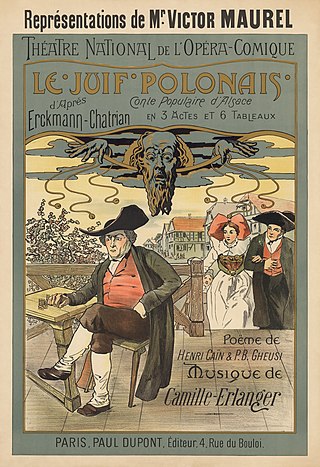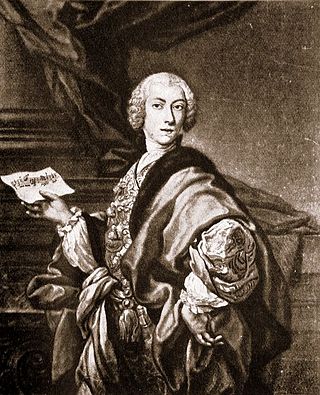Related Research Articles
Opera buffa is a genre of opera. It was first used as an informal description of Italian comic operas variously classified by their authors as commedia in musica, commedia per musica, dramma bernesco, dramma comico, divertimento giocoso.

Pietro Alessandro Guglielmi was an Italian opera composer of the classical period.

Das verratene Meer is an opera in two parts and 14 scenes, with music by Hans Werner Henze to a German libretto by Hans-Ulrich Treichel, after Yukio Mishima's novel The Sailor Who Fell from Grace with the Sea. Composed between 1986 and 1989, it was Henze's ninth opera, his third that he wrote for the Deutsche Oper Berlin.

Guntram is an opera in three acts by Richard Strauss with a German libretto written by the composer. The second act of the opera was composed in Ramacca, Sicily.

Bellérophon is an opera with music by Jean-Baptiste Lully and a libretto by Thomas Corneille and Bernard le Bovier de Fontenelle first performed by the Opéra at the Théâtre du Palais-Royal in Paris on 31 January 1679.
Mirandolina is a comic opera in three acts by Bohuslav Martinů, with a libretto by the composer after Carlo Goldoni's 1751 comedy La locandiera. Salieri had an opera on the same subject premiered at the Vienna Kärtnertortheater in 1773.

Le Juif polonais is a 1900 opera in three acts by Camille Erlanger composed to a libretto by Henri Caïn.
Il ratto della sposa is an opera buffa in three acts by Pietro Alessandro Guglielmi. The Italian libretto was by Gaetano Martinelli.
La pastorella nobile is an commedia per musica in two acts by Pietro Alessandro Guglielmi. The Italian libretto was by Francesco Saverio Zini.
Gennaro Astarita was an Italian composer, mainly of operas. The place of his birth is unknown, although he was active in Naples for many years. He began his operatic career in 1765, collaborating with Niccolò Piccinni in the writing of the opera L'orfana insidiata. He became the maestro di cappella in Naples in 1770.
Marcello Bernardini was an Italian composer and librettist. Little is known of him, save that he wrote 37 operas in his career. His father was most likely the composer Rinaldo di Capua.
Gaetano Monti was an Italian composer. His name is first recorded in 1758, when he was eight years old, singing in a small part in a performance of Il curioso del suo proprio danno by Niccolò Piccinni. His first opera, Adriano in Siria, was performed in Modena in 1775, and he was later named organist of the Treasury Chapel at Naples Cathedral; there he remained until 1788. Moreover, in 1776 he became an impresario at the Teatro San Carlo. Most of his works were opere buffe, and were seen in theatres in Rome, Venice, and Naples. His most popular works were Le donne vendicate and Lo studente. It was believed at one time that he was the brother of the poet Vincenzo Monti, but this is uncertain.

Teatro San Samuele was an opera house and theatre located at the Rio del Duca, between Campo San Samuele and Campo Santo Stefano, in Venice. One of several important theatres built in that city by the Grimani family, the theatre opened in 1656 and operated continuously until a fire destroyed the theatre in 1747. A new structure was built and opened in 1748, but financial difficulties forced the theatre to close and be sold in 1770. The theatre remained active until 1807 when it was shut down by Napoleonic decree. It reopened in 1815 and was later acquired by impresario Giuseppe Camploy in 1819. In 1853 the theatre was renamed the Teatro Camploy. Upon Camploy's death in 1889, the theatre was bequeathed to the City of Verona. The Venice City Council in turn bought the theatre and demolished it in 1894.

In music history, the Neapolitan School is a group, associated with opera, of 17th and 18th-century composers who studied or worked in Naples, Italy, the best known of whom is Alessandro Scarlatti, with whom "modern opera begins". Francesco Provenzale is generally considered the school's founder. Others significant composers of this school are Giambattista Pergolesi, Domenico Cimarosa and Giovanni Paisiello.
It is with the Neapolitan school...that the History of Modern Music commences—insofar as that music speaks the language of the feelings, emotions, and passions.
Romeo und Julia is an opera in two acts by Heinrich Sutermeister. The composer wrote the libretto, after Shakespeare's Romeo and Juliet.
Gaetano Martinelli was an Italian librettist active in the court theatres of Charles Eugene, Duke of Württemberg from 1766 to 1769 and in Lisbon as the court poet to Joseph I of Portugal and his daughter Maria I from 1769 until his death in 1802. He was one of a group of reforming Italian librettists which also included Calzabigi, Verazi, and Migliavacca, who moved away from the traditional Metastasian plot structures that had dominated opera during the first half of the 18th century. The majority of his early libretti were for comic or semi-comic operas.

For Giovanni Battista Pergolesi's L'Olimpiade, see L'Olimpiade (Pergolesi)
References
- ↑ Mary Hunter in New Grove Dictionary of Opera describes it as a dramma giocoso in her "Pietro Alessandro Guglielmi". Grove Music Online (8th ed.). Oxford University Press. 2001. doi:10.1093/gmo/9781561592630.article.O901986pg1. ISBN 978-1-56159-263-0., but as an opera buffa in her "La sposa fedele". Grove Music Online (8th ed.). Oxford University Press. 2001. doi:10.1093/gmo/9781561592630.article.O008557. ISBN 978-1-56159-263-0.. At this period, both designations may be equally correct.
- ↑ Or according to Mary Hunter in Grove, during Carnival 1767.
- Casaglia, Gherardo (2005). "La sposa fedele" . L'Almanacco di Gherardo Casaglia (in Italian).
- Hunter, Mary (1992). "La sposa fedele". Grove Music Online (8th ed.). Oxford University Press. doi:10.1093/gmo/9781561592630.article.O008557. ISBN 978-1-56159-263-0.